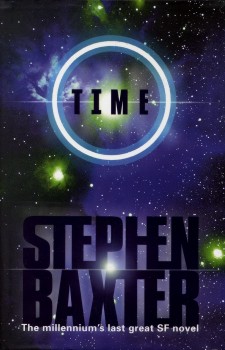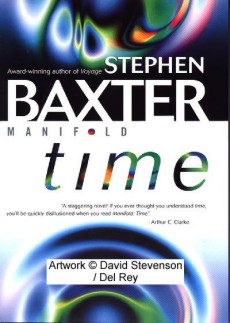Time:
![]()
![]()
This review was originally posted on Amazon.co.uk's website
Click here to read the book's blurb
Click here to see a larger picture of the US cover (thanks to the Baxterium for providing the picture)
Click here for an alternative review of Time from Infinity+
Click here for Keith Brooke's (founder of Infinity+) slant on this review
 |
|
The
UK cover of Time
|
Let me first say that I'm a great fan of Stephen Baxter's books. He's one of the UK's foremost science fiction writers, and novels such as Titan and Moonseed attest to that fact.
You can probably guess that I'm now going to say that I didn't like Time. In my opinion, Time was a major step back for Baxter. I've always admired his skills in dealing with 'hard' SF, and the way he manages to weave it into an engrossing plot. Unfortunately, in Time, he isn't up to scratch.
For the first part of the book, everything goes swimmingly. It reads like the old Baxter books we have known and loved - NASA acting stupid, a lone man standing against disaster and succeeding against all odds. Add a bit of hard science that's realistic yet intriguing, and you have a recipe for a bestseller.
After the first part of the book, it all goes downhill. The tantalising prospect of asteroid mining was wiped away in paragraphs. The storyline hops from character to character, never staying on one person long enough for you to identify with them. Small pieces of information presented as mini-chapters fly by, and ultimately don't amount to much at all. An entire mini-storyline of the book, involving the USA's effort of retribution against the hero, Malenfant, ends so abruptly that I was left wondering whether I'd actually missed out a dozen pages.
The squid characters, who seemed to so promising at the start, not unlike David Brin's Uplift characters, quickly disappeared from view. They just seem like some kind of plot device that's just thrown in for good measure, and discarded when the author has something better to write about.
It gets worse. Traditionally, Baxter's description of quantum physics and big-bang science has never been at fault. Until now. I've got a rudimentary knowledge of physics - I read New Scientist and the pop science books like Elegant Universe. Yet I still didn't have a clue about what the hell the characters were going on about. I still didn't, even when they performed a bit of data-dumping.
The whole 'universe-jumping' section, which went on for far too long to serve its purpose, left me wondering how it was supposed to be possible. Ditto the existence of life in the unimaginable future - with consciousness suspending in some kind of finite quantum matrix.
 |
|
The
US cover of Time
|
The 'Blue' super-intelligent kids left me floundering. Were they emissaries from the future? Were they communicating with the future? Were they just simply super-intelligent? Perhaps I'm slow for not figuring it out. And there's my ever present question. If humanity was supposed to collapse the vacuum state of the universe, why the hell didn't the future humans do it themselves, huh? Why go to the trouble of going back in time to work it all out then, denying humanity the fun it richly deserves by zooming around the galaxy?
Baxter simply tried too hard with Time. He threw in far too many new scientific ideas, many of which were incomprehensible, and there wasn't enough of a storyline. At the end, I thought, so what? I never really got to know the characters. I couldn't really give a (your choice of expletive) if they died or not. In one case, a character died, and lived. Don't ask me how.
Some of his old tricks are wearing thin now, as well. He's written one too many books where NASA and the US military bears the brunt of the author's scorn. Maybe it's justified, maybe it's not. But couldn't NASA be the good guys, for once? Then there's the idea that mankind is around to create daughter universes by producing black holes. Since I've recently read Earth, by David Brin, and Vacuum Diagrams, I'm getting a little tired of this.
I have nothing against Baxter. I personally think Vacuum Diagrams is the best collection of short stories I've ever read. After Moonseed and Titan, two outstanding novels, I was expecting more of the same. The Times reviewer claimed that Time put Baxter firmly into the ranks of Asimov, Clarke and Heinlein. Trust me - this isn't true. He'll have to try a lot harder to reach those heights.
